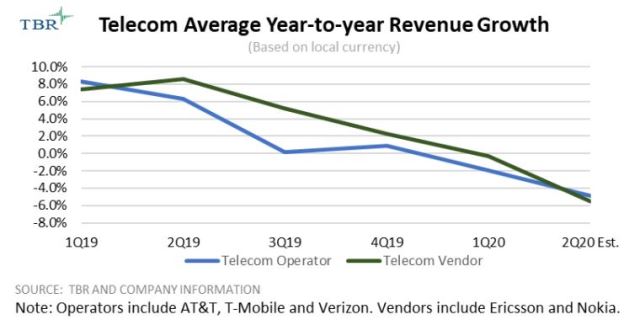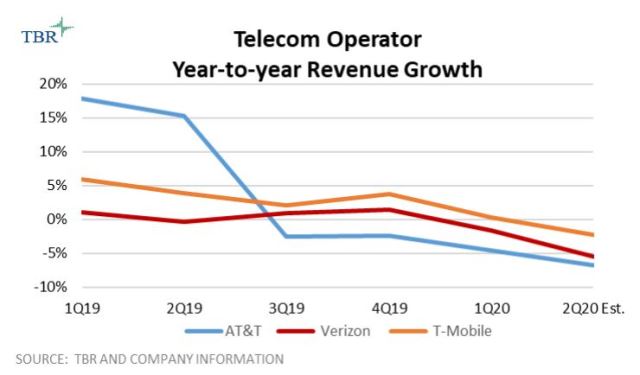The COVID-19 pandemic negatively impacted operators in Q1 2020. Though operators will be able to retain the bulk of their customers amid the pandemic due to network connectivity remaining essential to most consumers and businesses, store closures will result in decreased subscriber additions and device sales.
 TBR said COVID-19 will have a significant impact on operators’ media businesses, such as WarnerMedia and NBCUniversal, as the pandemic is resulting in delayed content releases and advertisers significantly reducing their spending budgets.
TBR said COVID-19 will have a significant impact on operators’ media businesses, such as WarnerMedia and NBCUniversal, as the pandemic is resulting in delayed content releases and advertisers significantly reducing their spending budgets.
U.S. mobile operator market
The impacts of COVID-19 will spur telecom innovation and development to help alleviate future pandemics. COVID-19 will have a material impact on most U.S. and Canadian operators’ financial and go-to-market performances in 2020 as the pandemic is having a significant effect on internal operations as well as customer behavior patterns.
COVID19 will serve as a catalyst to spur innovations in areas including 5G, IoT and edge computing to help alleviate the impact of future pandemics. TBR anticipates subscriber additions and churn rates in 1Q20 will be minimized by store closures as well as consumers not prioritizing switching wireless carriers due to COVID-19.
COVID-19 will result in heightened online service activations and device sales due to store closures and social distancing concerns. Operators’ financial performances in 1Q20 will also be impacted by initiatives to help support customers during the pandemic, such as waiving overage fees, providing extra data at no extra cost and launching low-cost service options such as T-Mobile Connect.

COVID-19 may delay 5G rollouts in the short term due to supply chain shortages of network equipment as well as technical staff being limited due to layoffs and furloughs. COVID-19 will also limit 5G adoption due to delayed smartphone production, including potentially a 5G iPhone model, as well as economic challenges preventing consumers from purchasing new handsets.
The pandemic will also drive 5G innovations to support the development of critical response IoT use cases in areas such as healthcare and smart cities while the rise of work-from-home environments will drive 5G fixed wireless expansion to optimize office applications and to extend residential broadband coverage to markets with limited or no wireline options.
AT&T
The economic and societal impacts of COVID-19 will create disruption and opportunity for AT&T. AT&T’s overall financial position will remain strong despite the impact of COVID-19. COVID-19 contributed to an estimated $605 million decrease in AT&T’s consolidated revenue in 1Q20, though the pandemic’s impact is expected to become more significant in 2Q20.
TBR anticipates AT&T’s consumer wireless activity, including subscriber additions and churn rates, will stagnate in 2Q20 due to the temporary closure of approximately 40 percent of AT&T’s company-owned retail stores.
COVID-19’s impact on wireless ARPU in 2Q20 will be mixed as economic challenges may spur some customers to switch to lower-priced wireless service plans, such as AT&T’s new 2GB prepaid plan for $15 per month, while other customers will migrate to unlimited data plans to support consumption demands. We also expect mixed results around the launch of HBO MAX and AT&T TV as demand for video content is escalating due to stay-at-home orders, but adoption of these services will be limited by economic challenges and less expensive streaming and linear-TV options offered by competitors.
AT&T’s financial performance in 2Q20 will also be impacted by initiatives to support customers during the pandemic, such as waiving overage fees and providing access to premium video content at no extra cost.
AT&T’s overall financial position will remain strong in 2020 as the company ended 1Q20 with $10 billion in cash on hand and gained financial flexibility by securing a $5.5 billion term-loan agreement at competitive rates from 12 banks in April.
AT&T also expects supply chain issues will be minimized due to its geographically diverse supplier base, and the company will bolster cash flow through divestments, including the sale of AT&T’s Puerto Rico and U.S. Virgin Islands operations.
Verizon
The COVID-19 outbreak will pressure Verizon’s consumer division but create opportunities among businesses and work-from-home employees. COVID-19 will challenge Verizon’s premium pricing strategies.
The COVID-19 outbreak directly contributed to lower equipment and Verizon Media revenue in 1Q20, though the pandemic’s impact is expected to become more significant in 2Q20. The temporary closure of approximately 70 percent of Verizon’s company-owned retail stores will cause consumer activity, including subscriber additions and churn rates, to stagnate in 2Q20.
However, TBR expects these closures will result in heightened online service activations and device sales for Verizon and that adoption of these platforms will remain elevated long-term in the aftermath of the pandemic as wireless customers become more accustomed to digital transactions.
Verizon will not experience significant wireless subscriber losses due to COVID-19 as cellular connectivity is essential for most consumers. Economic challenges will cause some customers to seek less expensive service options due to Verizon’s premium pricing. Verizon’s wireless service revenue in 2Q20 will also be impacted by lower roaming revenue as well as initiatives to support customers during the pandemic, such as waiving overage and late fees and providing extra data at no cost.
COVID-19 will have a significant impact on Verizon’s equipment revenue in 2Q20 as device upgrades will be deprioritized due to economic challenges and uncertainties. 5G adoption will be limited due to the high price tag of most initial 5G handsets. However, Verizon plans to offer 5G smartphone models under $600 beginning in 2H20 to accommodate price-sensitive customers.
T-Mobile
COVID-19 will limit subscriber growth and increase operating costs for T-Mobile in 2Q20. T-Mobile incurred $117 million in costs related to COVID-19 in 1Q20 due to increased expenses in areas including supplemental employee payroll, third -party commissions and cleaning costs.
COVID-19 also negatively impacted T-Mobile in areas including lower subscriber additions and device sales due to store closures as well as higher bad debt expenses from delinquent bill payments.
The negative impact of COVID-19 will intensify in 2Q20 as T-Mobile expects to incur between $450 million to $550 million in related costs and only garner up to 150,000 postpaid net additions in the quarter.
The temporary closure of approximately 80 percent of T-Mobile’s company-owned retail stores will cause consumer activity, including subscriber additions and churn rates, to stagnate in 2Q20.
Increased adoption of digital sales platforms due to store closures will enable T-Mobile to accelerate retail rationalization in the wake of the Sprint merger, which will help improve margins, as customers become less dependent on brick-and-mortar stores to fulfill transactions.
The increased prevalence of work-from-home environments will continue long-term as businesses reap the benefits of decentralization, including greater employee flexibility and reduced facility expenses.
Though cable and wireline providers are better positioned currently to support demand for residential broadband, T-Mobile has the opportunity to more effectively support work-from-home employees through its fixed-wireless services, which are expected to reach 52 percent of U.S. ZIP codes by 2024, as well as introducing higher data limits for its mobile hotspot plans.





